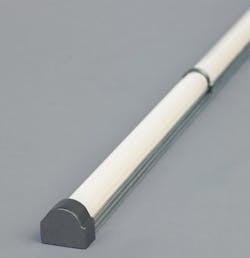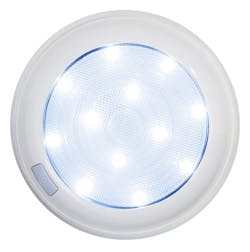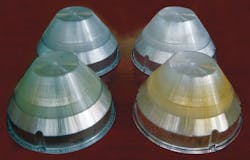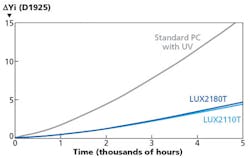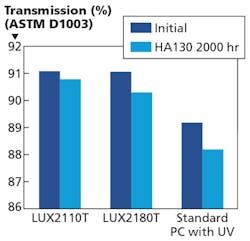Polycarbonate resins have evolved to deliver excellent optical and aging properties, writes VENUGOPAL KOKA, and the moldable plastics can help SSL product designs meet consumer cost targets.
As the adoption rate of LED-based lighting continues to climb, lighting manufacturers are looking beyond materials traditionally used in lighting applications to drive innovative designs and form factors, support higher efficiency, and overcome persistent cost barriers to adoption. While manufacturers have traditionally used polymethyl methacrylate (PMMA) - and to a lesser extent, glass - for solid-state lighting (SSL) applications, polycarbonate resins (PC) are increasingly the preferred material for lenses, covers, tubes, pipes, diffusers, and reflectors. Today approximately 90% of the retrofit LED lamps replacing incandescent bulbs are made with PC materials.
Related article: Optics place LEDs in the right light
LED designers achieve a number of benefits by selecting PC over glass and PMMA, including greater impact and heat resistance, improved flammability ratings, and increased design flexibility. While glass and PMMA remain competitive with PC thanks to their high light transmittance and strong weather resistance, the newest grades of specialty PC are quickly closing that gap. As a candidate material for LED devices, polycarbonate presents a formidable challenge to glass and PMMA and is powering advances in residential, commercial, and outdoor LED design.
PC opens residential market
The residential lighting market is ripe with opportunity for LED lighting. According to a 2012 McKinsey report, the LED share of the total residential market was a mere 7% in 2011 but is expected to rise to 50% by 2016, and to 70% by 2020.
The transition away from traditional lighting sources has already started in many countries, thanks to heightened concern for energy conservation among consumers and government regulation aimed at phasing out low-efficiency bulbs. But to unseat incandescent and compact fluorescent lamps (CFLs) entirely, LEDs must address the issue of cost, which remains one of the key barriers to the mass-market adoption in the residential market. For demand to grow, consumers need to see and understand the benefits of investing in technology with a longer shelf life.
Related article: Incandescent bulb legislation doesn't matter
Durability and impact resistance are essential criteria in residential settings, as it's not uncommon for occupants to drop or mishandle their replacement lights while fitting them. PC offers impact resistance, measured in the lab as the kJ/m2 (kilojoules per square meter) required to break a sample under flexural impact, that is significantly higher than that offered by glass and PMMA. PC surpasses the performance of PMMA by a factor of 10 in practical impact measurements and that of glass by a factor of 30.
LED devices produced with PC are also safer than those made using PMMA, which does not perform as well in terms of flame retardancy and thermal resistance. Certain PC grades earn the "5VA" rating - the highest rating for flame retardancy - under UL 94, the standard that classifies plastics according to how they burn in various orientations and thicknesses. PMMA, on the other hand, earns a UL 94 rating of "HB," the lowest classification in the ranking. Moreover, PC can be used continuously in temperatures that go up to 130°C, whereas PMMA can only go up to 90°C. Table 1 summarizes the characteristics of PC and PMMA that are important for SSL product developers.
Creating softer SSL lighting
To grow demand for LEDs in the residential setting, lighting designers must also address the quality of LED lighting devices, making the light softer and closer to that of incandescent bulbs. Diffusion materials with a milky or frosted effect can shield the LED light source, helping to distribute light evenly and minimize glare. Without diffusion, the LED light source can create harsh white hot spots.
At the same time, designers must balance the aesthetic demands for soft white light with concerns about transmission. Too much diffusion can mean excessive loss of illuminance, making the bulb less efficient.
PC excels in striking the delicate balance between diffusion and transmission. The newer generations of polycarbonates can shield hot spots without compromising light transmission.When used in LED globes or lens covers, PC provides effective diffusion, without the need for secondary lenses or components, thus eliminating cost, complexity, and weight. Diffusers made with PMMA typically require multiple components, adding weight and complexity to LED designs.
Table 2 shows the transmission and optical scattering offered by PC grades available to today's LED designers. The transparent grade of SABIC's LEXAN LUX C resin portfolio delivers transmission of 91.5% at 1 mm, a significant improvement over conventional PC, which achieves around 89%, and a close second to PMMA, which achieves 92%. For lighting applications that require greater diffusion, LEXAN LUX C resin diffuse grades scatter the light-shown in Table 2 as the degree of light dispersion (DLD), or the angle at which half of the luminance of the incident light is observed without experiencing a significant decrease in transmission.
TABLE 1. Comparative specifications for PC and PMMA.
Polycarbonate | PMMA | |
Flammability (UL94 rating) | 5VA---V2 | HB 1.6 mm |
Heat deflection temp. (0.45 MPa) (°C) | 131 | 103 |
Stress break (MPa) | 70 | 77 |
Impact resistance (Charpy impact strength | No break | 20 kJ/m2 |
Refractive index | 1.58 | 1.49 |
Creating lighting uniformity and consistency also poses difficulties for industrial and commercial LEDs, but PC has proven effective in these settings. Intematix Corporation, a manufacturer of phosphor materials and optics for LED lighting, selected SABIC's LEXAN LUX resin in transparent, diffusion, and reflective grades to create the ChromaLit Linear lighting system (Fig. 1).
ChromaLit is built with remote phosphor technology, which uses a phosphor component separated from the blue LED energy source to help generate better light diffusion. The separation of the phosphor from the energy source results in better lighting uniformity. The ChromaLit Linear system delivers naturally uniform, high-quality light with conversion efficacy of up to 215 lumens per radiant watt or up to 163 lm/W at the system level when used with the most efficient blue LEDs available.
Design flexibility for commercial lighting
Manufacturers of commercial and industrial LED lights are faced with many of the same challenges seen in the residential market. Lighting designs must be functional, attractive, and lightweight while also delivering high optical efficiency and light uniformity.
TABLE 2. Transmission and degree of light dispersion for transparent and diffuse PC grades.
Transparent LUX C 1 mm | Diffuse LUX C 1 mm | |
Transmission (%) | 91.5 | 89.4 |
DLD (deg.) | N/A | 7/1 |
To meet these complex criteria, manufacturers seek materials that offer design flexibility, an area where glass and PMMA lag behind PC. In particular, PC can be used to create sharp corners and notches - design features that further accentuate PMMA's weakness in impact strength. Moreover, PMMA can't maintain the high level of durability and rigidity made possible with PC in ceiling LED applications, such as the one shown in Fig. 2.
PC can also be used in snap-fit applications, in contrast to other materials such as glass, which require a less effective glue system. Unlike adhesive assemblies, LED lamps and luminaires made with snap-fit connections can be easily disassembled without destroying parts, thereby reducing lifecycle costs and environmental impacts such as end-of-life cost as documented by the European Commission. For more information on lifecycle impact, see Table 3.
Another fundamental obstacle facing commercial LED designers is freeing light trapped inside the optical system, a design flaw that reduces light output while generating unwanted heat that can reduce the reliability and lifetime of the device. Lenses made of PC have a high refractive index that can help optimize light extraction, and can also integrate the reflector into the LED module, allowing for thinner lenses and the creation of lighter designs. With a PC lens, a PC reflector could also be effectively integrated into the optical system. By maximizing the illuminance of LED modules with a lens and reflector, the benefits of PC over PMMA are clear.
PC also gives manufacturers a choice for processing methods, which may range from injection and blow molding to extrusion, enabling molded-in color and the ability to create dynamic and curvy shapes. While PMMA can also be processed with a variety of methods, PC materials earn better marks for sustainability and lifecycle impact as measured by global warming potential and total energy demand (see carbon entry in Table 3).
Improving LED performance outdoors
LEDs are increasingly used for architectural lighting, exterior and street lighting, and automotive applications. While sharing many of the challenges faced in the residential and industrial setting, outdoor LED designs must account for the impact of long-term exposure to sun, rain, wind, heat, humidity, and cold.
While PMMA performs better than PC with regard to weather and ultraviolet (UV) radiation resistance, PC continues to make gains in these areas. For example, SABIC's LEXAN SLX resin was specifically designed to close the gap between PC and PMMA for outdoor applications. The LEXAN SLX resin resists yellowing due to UV exposure and retains its gloss, color stability, and mechanical properties more than five times longer than standard PC. Standard PC can degrade with UV exposure, diminishing the component's ductility and making it brittle. The outdoor lighting lenses in Fig. 3 demonstrate the comparative yellowing of a component made with LEXAN SLX resin and with standard PC after 2900 hours of ultraviolet (UV) exposure. To capture the difference, the lenses were placed in a hot chamber with a175W metal halide (MH) lamp for the 2900 hours at 120°C on the refractor.
The LEXAN SLX resin also eliminates the need for a secondary UV coating. Reducing complexity and integrating parts has become increasingly critical for lighting designers. One of SABIC's outdoor lighting customers will soon launch a new LED fixture that replaces PMMA with PC. The new design reduces complexity by replacing a PMMA lens and PC lens cover with a single, integrated PC component and delivering improved light output.
In outdoor applications, brightness and high optical clarity are also critical success factors. While glass and PMMA achieve higher light transmission, continuous advances in PC materials have all but leveled the playing field. At 2.5-mm wall thickness, improved-clarity PC materials can provide approximately 90% light transmission, on par with high-heat PMMA and 2% behind standard PMMA.
TABLE 3. Comparative environmental intensity and lifecycle impact for LEXAN resin versus PMMA.
Impact category (unit) | LEXAN | PMMA |
IPCC GWP 100a (kg CO2 equiv.) | 4.1 | 7.0 |
Total energy demand (MJ) | 104 | 128 |
The evolution of polycarbonate
Advances in PC technology have significantly improved the applicability of PC for LEDs. Materials manufacturers such as SABIC have invested in the development of PC materials that expand design freedoms through lower weight, better mechanical properties, enhanced aesthetics, and fewer secondary operations.
Fig. 4 compares the heat aging of SABIC's LEXAN LUX resin grades to standard PC with a UV additive. When tested up to 5000 hours at 130°C, standard PC exhibits a much greater color shift - represented by the increase in delta Yi or yellowness index - than the two grades of LEXAN LUX resin tested (2180T and 2110T).
Due to the exceptionally long lifetime of LED devices (as long as 10-15 years), longevity is also a critical factor for LED components and materials. As shown in Fig. 5, SABIC's LEXAN LUX resin grades maintain their transmission percent better than standard PC after 2000 hours of heat aging.
Working with polycarbonate
While differences in the refractive index (RI) must be accounted for, designers and OEMs can develop products with PC in much the same way they develop products with PMMA and glass. Though the same predictive modeling tools can be used, SABIC also offers Bidirectional Scattering Distribution Function (BSDF) files that enable product engineers to predict the results of their design for both clear and diffusion materials. Furthermore, PC is processed using the same type of molders as PMMA - injection molders, extruders, and blow molders. Working with PC that meets the UL 94 flame rating can also shorten the product development timeline and can potentially eliminate the need for device flame testing.
While the future is bright for LED technologies, they are still at a relatively early stage of development and have yet to achieve the mass market breakthrough that will make them the predominant form of lighting in residential, commercial, and outdoor settings. However, manufacturers and engineers are taking these challenges head on, and exciting new designs are emerging every day. Addressing the complex and ever-changing specifications of the LED industry will require continued investment in new and improved PC materials. SABIC is committed to working with stakeholders across the lighting value chain to power the next generation of LEDs.
VENUGOPAL KOKAis the director of electrical and lighting marketing for SABIC's Innovative Plastics business unit (sabic-ip.com).

